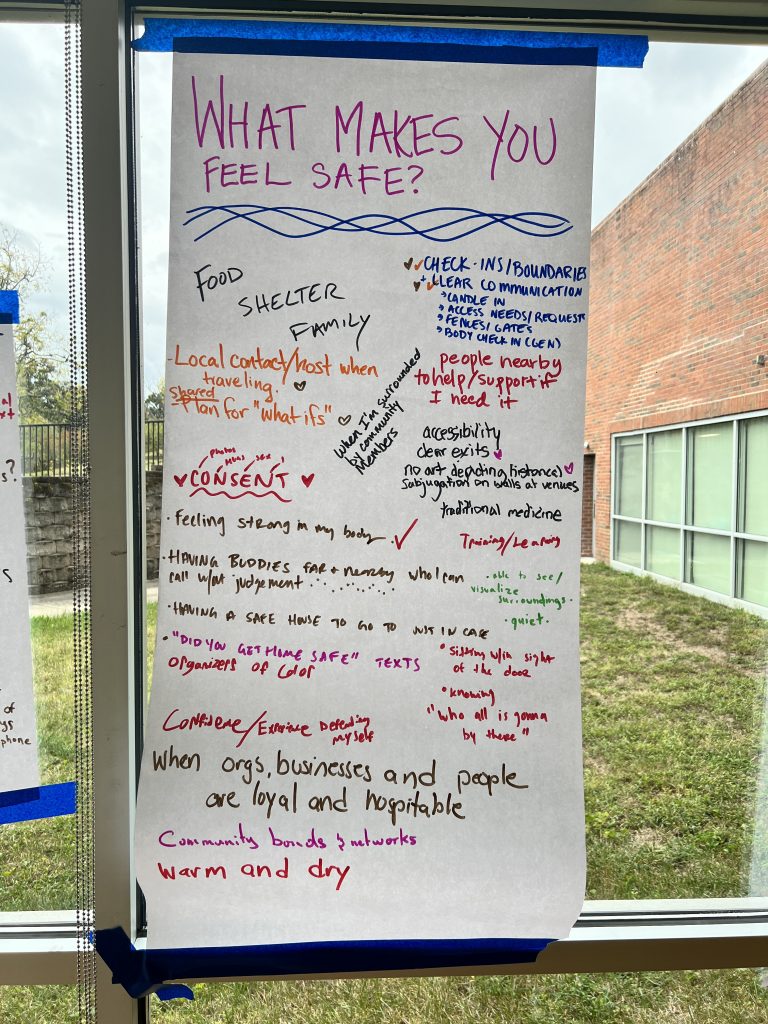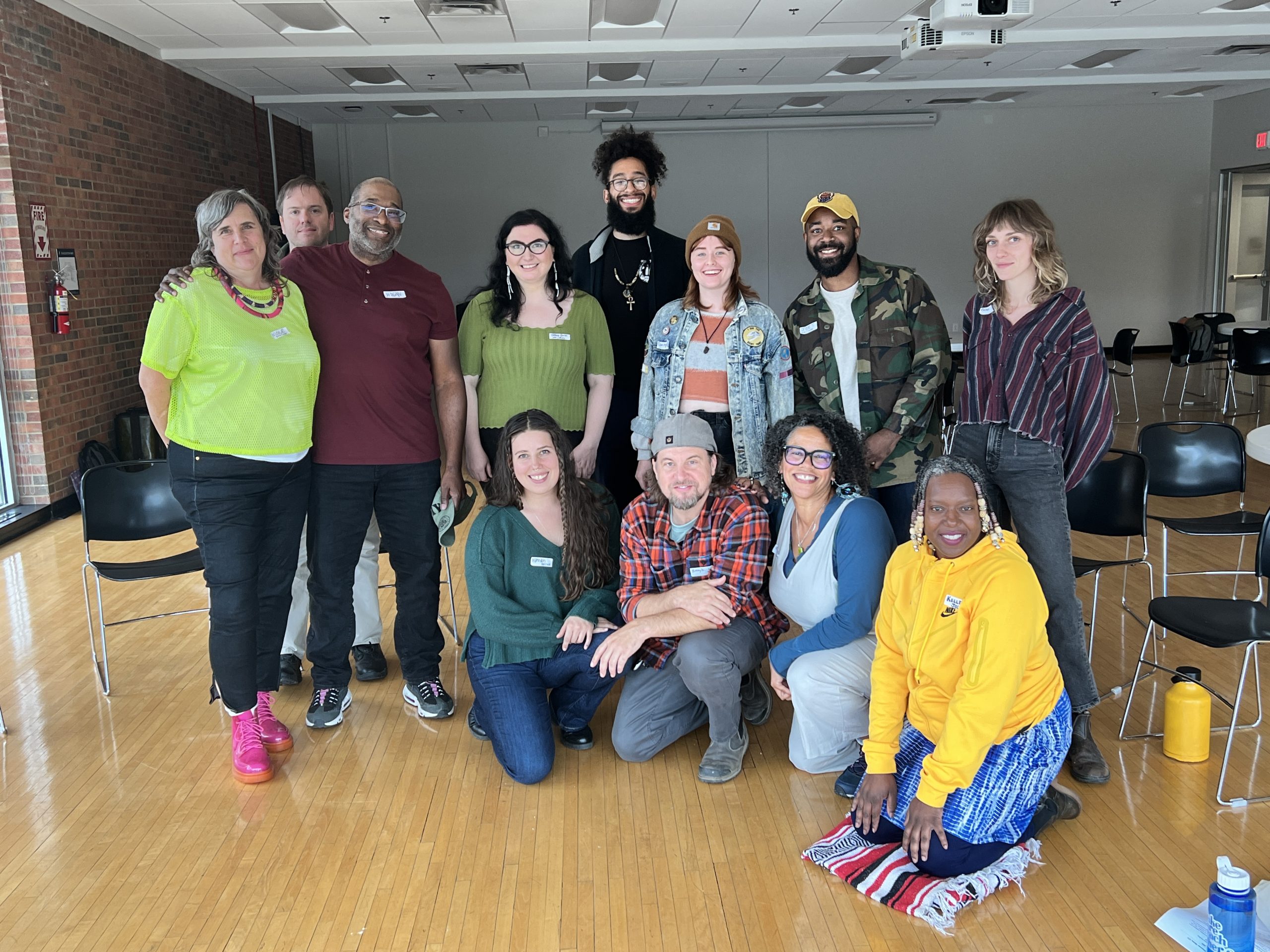ROOTS Weekend Rhizome: Berea, KY October 14, 2023. Photo by Garrett Blaize.
March 2024 | Nicole Garneau
How do artists and activists gather safely in Eastern Kentucky and other places?
This question was a generative starting point for the October 2023 ROOTS Rhizome Weekend in Berea, Kentucky, and it resonated particularly strongly for many folks who gathered at Berea College in a room looking out onto the misty autumn foothills of Appalachia. In fact, the entire reason we were in Berea for one day instead of at the Pine Mountain Settlement School in Harlan County for a full weekend was because of safety concerns for our people. You can learn more about the white/Christian supremacist intimidation experienced by our Southern arts and movement partners, Waymakers Collective (including many ROOTS members) in this article.
ROOTS Weekend: Harlan County was canceled in September 2023 because we were not able to find a safe and accessible meeting space in Kentucky for a large group on short notice.
As a group, we decided instead to focus on a one-day learning exchange about Community Safety as a way of actively engaging the very real threats that are faced by artists and activists in the US South: especially BIPOC and/or LGBTQIA people. We were guided in this process by Malcolm Davis, 3rd Generation ROOTS member and Berea resident, who was also present at Pine Mountain Settlement School during the Waymakers Gathering.
To extend the learning, we are sharing some of the questions, practices, and strategies that are on our minds as we plan gatherings centering social and racial justice.

Malcolm Davis leads discussion while Rachel Meirs takes notes. ROOTS Weekend Rhizome: Berea KY October 14, 2023. Photo: Nicole Garneau
Operational Security (OpSec): how do we organize and protect our gatherings in order to keep our people safe? These questions apply to all levels of the space, organization, and historical context.
- Privacy: who holds information about who is in the space and what comes out of the space?
- Online presence and monitoring:
- In spaces without reliable internet and cell service, the majority of people gathered may be offline
- Who do we have “on the outside” to monitor online chatter?
- Have we considered encrypted communication?
- Venues: understanding and preparing for where we are, what is happening, and who is there and nearby
- Rental agreements/contracts should be specific, intentional, and clear
- Venues and staff should be vetted
- Agreements should be made about surveillance of participants and by whom
- Venues and organizations should all have safety plans
- Plans should be made ahead of time about how to engage with security, police, and emergency services
- Safety in Rural Spaces: understand communication challenges like bad cell service; consider CB Radio or walkie-talkies; know how the space can and will be accessed (multiple ways in and out?)
- Welcoming: having a visible, enthusiastic, and forward-facing welcome process IS a safety strategy
- Traveling to and from spaces: assign buddies; request check ins when folks leave and arrive; educate folks about their surroundings; make sure folks have plenty of gas and phone battery (and portable cell phone batteries)
- Should we create an Alternate ROOTS “Green Book?”
Self Defense: how do we think and plan expansively around this concept?
- Find ways to make self-defense knowledge and skills known and accessible across an organization
- Examine what accessibility looks like in the context of self-defense
- Transparency around accessibility: self defense as taking care of each other rather than inflicting harm on someone else
- Communicate and set boundaries about what we use for self-defense, the tools available, and when or how those tools end up in our spaces (i.e. weapons)
- Broadly share the stakes for collective safety
Community Safety: how do groups like Alternate ROOTS build safety practices into our gatherings?
- Venues: look for organizations/venues that are run by/centering people of color; clearly prioritizing accessibility; and open to/for members of our community. Communicate with surroundings and neighbors
- Best practices for safe gatherings:
- We understand the security
- Local contacts know the physical space and cultural practices
- We come into the space “right”
- Our people are empowered and vocal
- We make plans within our community for crisis: natural or human-made and agree on “what-if” scenarios
- Accountability for members of the community: communication that can sometimes be called “gossip” can also be a safety mechanism. For example, sometimes we need to warn others about folks with a history of unsafe or problematic behavior within the group
- Knowing what conversations are happening and sharing the burden of monitoring that discourse

ROOTS Weekend Rhizome: Berea KY October 14, 2023. Photo: Nicole Garneau
Crowdsourced Resources for Community Safety in the US South: People, organizations, trainings, practices, web sites, books)
- Clear Creek Creative, Safe Space outside Berea, KY
- Arts Exchange, Safe Space in Atlanta, GA
- Southern Movement Assembly’s Guide for Building a Safety Plan (work-in-progress)
- Digital Defence / Digital Defense
- Socialist Rifle Association
- CPR / Basic First Aid: Stopthebleed.org
- Zine: Anarchist’s Guide to Basic First Aid
- Security Walls: Security company in Knoxville, TN
- “Gossip Saves Lives” the notion that sometimes talking behind other people’s backs is necessary when we need to warn folks about dangerous people
Things that Make us Feel Safe (a crowdsourced list)
- Food
- Shelter
- Family
- Check-Ins and boundaries
- Clear communication
- Access needs and requests
- Fences and gates
- Body check-in
- Local contact / host when traveling
- Shared plan for “what ifs”
- When I am surrounded by community members
- People nearby to help / support if I need it
- Having buddies far and nearby who I can call without judgment
- Accessibility: Clear exits
- No art depicting historic subjugation on walls at venues
- Traditional Medicine
- Consent for photos, hugs, & sex
- Feeling strong in my body
- Having a safe house to go to just in case
- Ability to see/visualize surroundings
- Quiet
- “Did you get home safe?” texts
- Events organized by people of color
- Sitting within sight of the door
- Knowing “who all is gonna be there.”
- Confidence / experience defending myself
- When organizations, businesses and people are loyal and hospitable
- Community bonds and networks
- Training and learning
- Being warm and dry
Nicole Garneau, photo by Christa Holka
NICOLE GARNEAU
she/her/hers
Nicole Garneau is an interdisciplinary performing artist. Her book Performing Revolutionary: Art, Action, Activism was published in print in Spring 2018 by Intellect. In 2022, she narrated and released the audiobook version. Originally from Chicago, she now lives in Rockcastle County, Kentucky, where she teaches, makes theater, facilitates meetings, and throws parties. She is a member of Alternate ROOTS and an Appalachian Teaching Artist Fellow. She is a Master Trainer with TimeSlips Creative Storytelling, and was forever changed by her experience manifesting wildly creative projects in rural Kentucky nursing homes in collaboration with staff and residents in 2018-2019. Originally from Chicago, she now resides in Rockcastle County, Kentucky, where she nurtures a multi-year collaboration with Clear Creek Creative. She maintains an active practice as a performing artist, most recently performing in the national tour of Ezell: Ballad of a Land Man, Faultline Ensemble’s This Place is a Message, Double Edge Theater’s The Hidden Territories of the Bacchae, and her own new performance work called Prophet. She is currently producing the 2nd Annual Rebellious Performance Retreat. Nicolegarneau.com


